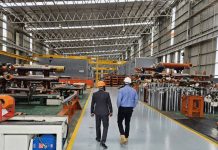Depending on which side of the fence one sits, mining is either a massive contributor to employment and economic growth, or it is not contributing enough and needs to be reformed.
This difference was of opinion was evident right at the start of this year’s Zimec conference, which took place in Lusaka last week (June 21-22).
In a keynote speech read out on his behalf, Hon. Richard Musukwa, Minister of Mines and Minerals Development, said that the more than $13 billion of investment into the mining sector since 2000 had not stimulated growth and diversification in other sectors of the economy.
“The government is working to change this situation. The performance of the sector will now be assessed on the basis of growth of linkages with other sectors and the impact on the lives of ordinary Zambians.”
Shortly afterwards, John Gladston, Government Affairs Manager for First Quantum Minerals (FQM), made a presentation on the impact of FQM’s $2.1-billion Sentinel Mine in North-Western Province. His message was that mining does indeed contribute to the economy and impacts the lives of ordinary Zambians.
Mines believe they contribute massively, but this view is not widely shared
Sentinel broke ground in 2012, and production started in 2015. It is one of the world’s most modern and technologically advanced mines.
Gladston said that although the company was not yet profitable, it had already paid more $300 million in Mineral Royalty Tax, various duties and the tax contributions of its employees. The company had built an entire town, Kalumbila, where some 10 000 inhabitants live, and where a $40-million mill-ball manufacturing facility (a Chinese-Chilean joint venture) will be opening soon – it will employ 150 people, export mill-balls to the Congo, and generate foreign earnings for Zambia.
Gladston said that it was Kalumbila’s intention to match the massive tax contribution of its sister mine, Kansanshi, which is Zambia’s largest taxpayer, having contributed some $3.5 billion in fiscal revenues in the past decade.
So, there is clearly a mismatch in perceptions in terms of mining’s contribution to economic growth and the impact of the lives of ordinary Zambians. Mines in general believe their contribution is massive, a view that is not always shared by the government – or indeed the population at large.
Jackson Sikamo, Chairman of Chibuluma Mines on the Copperbelt, said in an interview at Zimec: “New mines have come up in the bush. Serious towns have been put up in previously remote areas. Mining’s contribution to the development of the country is very high. But this is not always acknowledged by the general populace; perhaps the mining companies themselves need to communicate this better.”

Sikamo points out that if one averages out the total investment into the mining industry since privatisation took off in 2000, around a billion dollars has been invested every single year. In addition, the industry spends between $2 billion and $5 billion every year on supplies and inputs, ranging from fuel, food and services to specialised equipment and machinery. Even though many key items are imported, they are brought here by Zambian transporters using Zambian infrastructure; the transactions are routed through Zambian-registered companies and benefit the Treasury.
Earlier this year, the Chamber of Mines issued a report entitled The 10-year miracle – the story of mining in North-Western Province. It paints a vivid picture of how a remote, rural province and its sleepy provincial capital, Solwezi, have been transformed into a major commercial centre that today produces two-thirds of Zambia’s copper.
The economic effects of the province’s three new mines have been significant and far-reaching, thanks to the monthly wages of some 20 000 employees and contractors, and each mine’s daily supplier spending on goods and services in the local economy.
The presence of the mines has given birth to hundreds of businesses large and small, ranging from transport companies, auto-repair and hotels to shopping malls, banks and insurance companies. Moreover, thanks to the multiplier effect, each direct job at the mines has resulted in several jobs elsewhere – not just in the province, but as far afield as Lusaka and the Copperbelt.
What the report demonstrates is that the mining industry does indeed make a massive contribution to economic growth, employment and the lives of ordinary Zambians – not just in mining but in many other industry sectors.
Of course, this does not detract from the valid point made by the Mines and Mineral Development Minister at Zimec that the economy needs to be diversified away from mining so that it is no longer just a source of government revenue, but the platform for much broader economic development.
However, for the mining industry and the government to successfully work towards this essential objective, there needs to be a shared understanding of mining’s existing contribution to the economy and the lives of ordinary Zambians.
Only once the mining industry and policymakers are in agreement on mining’s current contribution can a coherent policy be formulated for its future contribution.
























